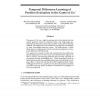Free Online Productivity Tools
i2Speak
i2Symbol
i2OCR
iTex2Img
iWeb2Print
iWeb2Shot
i2Type
iPdf2Split
iPdf2Merge
i2Bopomofo
i2Arabic
i2Style
i2Image
i2PDF
iLatex2Rtf
Sci2ools
NIPS
1993
1993
Temporal Difference Learning of Position Evaluation in the Game of Go
The game of Go has a high branching factor that defeats the tree search approach used in computer chess, and long-range spatiotemporal interactions that make position evaluation extremely difficult. Development of conventional Go programs is hampered by their knowledge-intensive nature. We demonstrate a viable alternative by training networks to evaluate Go positions via temporal difference (TD) learning. Our approach is based on network architectures that reflect the spatial organization of both input and reinforcement signals on the Go board, and training protocols that provide exposure to competent (though unlabelled) play. These techniques yield far better performance than undifferentiated networkstrained by selfplay alone. A network with less than 500 weights learned within 3,000 games of 9x9 Go a position evaluation function that enables a primitive one-ply search to defeat a commercial Go program at a low playing level.
Related Content
| Added | 02 Nov 2010 |
| Updated | 02 Nov 2010 |
| Type | Conference |
| Year | 1993 |
| Where | NIPS |
| Authors | Nicol N. Schraudolph, Peter Dayan, Terrence J. Sejnowski |
Comments (0)

